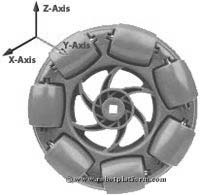Robot Locomotion
Robots can be either mobile or stationary. Mobile robots include rolling robots, crawling robots, swimming robots and many more. Stationary robots include robot arm, robot face, industrial robots etc. Although known as stationary, these robots are not actually motionless, but are confined to a small boundary. Each of these robots are designed to work on different platforms and the most common ones work either on Land, Air, Water, space etc. Some of the robots are designed to work on more than one platform and can shift from land to water to air. Based on the way robots move, they can be further classified as "Holonomic" or "Non-Holonomic" drive Robots
 Holonomic and Non-Holonomic Drive
Holonomic and Non-Holonomic Drive
Holonomic Drive
Holonomic refers to the relationship between controllable and total degrees of freedom of a robot. If the controllable degree of freedom is equal to total degrees of freedom, then the robot is said to be Holonomic. A robot built on castor wheels or Omni-wheels is a good example of Holonomic drive as it can freely move in any direction and the controllable degrees of freedom is equal to total degrees of freedom. The image shows a castor wheel which can rotate in both X-axis and Y-axis making it move in both the directions.
Non-Holonomic Drive
If the controllable degree of freedom is less than the total degrees of freedom, then it is known as non-Holonomic drive. A car has three degrees of freedom; i.e. its position in two axes and its orientation. However, there are only two controllable degrees of freedom which are acceleration (or braking) and turning angle of steering wheel. This makes it difficult for the driver to turn the car in any direction (unless the car skids or slides).
Redundant Drive
What if the controllable degrees of freedom are more than the total degrees of freedom? Then the controls are considered to be redundant. A robot arm or even a human arm has only six degrees of freedom, but seven controllable degrees of freedom. (Try twisting and rotating your arm and find out what are the seven degrees of freedom, including shoulder, elbow and wrist).
Do you have anything to say?
Visit the Forum to discuss, learn and share anything related to robotics and electronics !!








